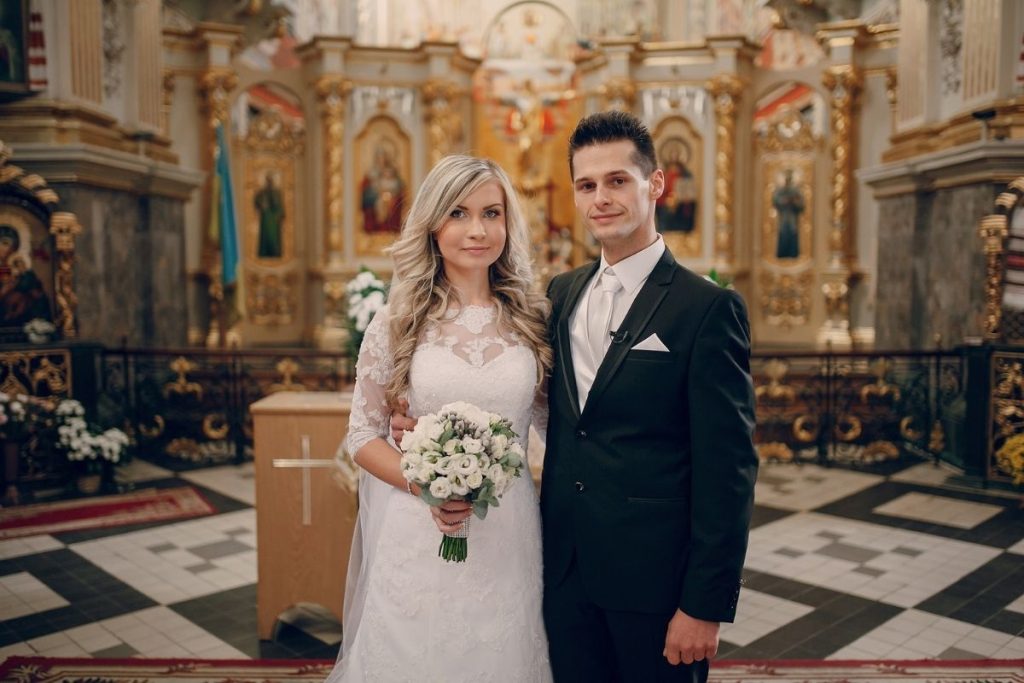What side does the bride stand on, in the church when you get married.
This is a good question and one that I get asked very frequently. In the vast majority of Christian denominations, the bride stands on the left side of the church.

However, there are some exceptions to this rule that people believe and follow
Eastern Orthodox Churches – In these traditional churches, brides always stand on the right-hand side of their grooms. The reason behind this tradition dates back to when Christianity was created by Emperor Constantine in 313AD. Back then people worshipped toward Jerusalem and followed a divine commandment which stated that Jews should face neither East nor West while praying (i.e., they were not allowed to pray to face toward Jerusalem). To avoid having people turn their backs towards Jerusalem while standing in worship facing East, they were told instead to stand facing North (where the enemy was). Thus, brides started standing on the right-hand side of the grooms because it was believed to be the “enemy’s” side. This tradition is still maintained in many Eastern Orthodox churches today.
In most Christian denominations which have a concept of Holy Orders, such as Catholicism and Anglicanism, priests would stand on their left sides so that they could hold out their right hands to bless those individuals being ordained into the holy orders. Since a priest has been ordained into the Holy Order of bishops, he stands on his fellow co-ordinator’s right-hand side during a Co-ordination service where he will be consecrated as a bishop alongside another individual As you can imagine, doing this does not give the priests much room to make the sign of the cross outwardly with their right hands.
What side does the bride stand on?
Some brides may simply wish to be contrary, and choose instead to stand on the left side of their groom. This isn’t an “official” tradition or anything that I would encourage you to do, but it is certainly allowed!
When you are getting married, there are some things that you will need to decide — the cake, the dress, and of course where to stand during your wedding. You can choose to have your bride’s side or the groom’s side. Some couples choose to split the difference and have their mothers each stand on one side with him standing in the middle.
What many people don’t realize is that there are actually specific traditions associated with where the brides stand in a religious wedding ceremony within different faiths. There is even a historical explanation behind why brides stood on certain sides during weddings based on gender roles of subservience.
Traditional Mormon temple wedding photograph – note how the woman stands on what appears to be “the left”.
According to the New Testament, Jesus Christ was crucified on the right hand of God and this became associated with being blessed. Additionally, priests would stand to the left of congregations during sermons so they could be seen by all members and no one had their back facing anyone. There is a tendency in most cultures for people to open up their bodies with arms and legs spread out wide when they feel safe and protected — as if they’re about to hug someone or something — rather than closed off.
Customary for brides
It was customary for brides to stand on the groom’s left-hand side since that was his (assumed) dominant hand; therefore, he would protect her with that arm as she stood next to him. This tradition continued even after wedding traditions evolved from having brides stand next to their grooms to symbolize the groom’s responsibility to protect her, even after marriage.
In Judaism
In Judaism, brides traditionally stand on the groom’s right-hand side because a blessing is made when a bride enters the marriage with all of her original equipment (right hand), and she leaves it behind in favor of what will be given to her by her husband (left hand). [The article then discusses how other religions have different traditions for this.]
In Christianity, brides stand on the left-hand side of the groom because traditionally women were considered property at that time and would therefore enter into marriages from their father’s home into their husband’s home. If they stood on his right hand instead of his left, they would exit their father’s home to enter their husband’s traditions specific to certain faiths.
Finally, there are one or two denominations that allow women to become pastors. Now, this is a topic in itself, but generally speaking, these denominations hold that women should not take any role in ordination (which means they cannot stand as bishops alongside men and can’t serve as pastors either). So these churches tend to follow the Orthodox tradition: brides always stand on the left side of their grooms.
Some brides may simply wish to be contrary (e.g., as such as a protest about women not being allowed to become pastors). I don’t encourage this, because it isn’t an “official” tradition or anything that I would encourage you to do, but it is certainly allowed! If this is what you want to do then go for it and enjoy your wedding day. It’s all part and parcel of the fact that we need to make room for expression and creativity even in the traditions we uphold most strongly.
What a bride does during the wedding
During the ceremony, the bride will stand on the left of where the groom will be standing. This is so that they can lead to each other and exchange their vows. To begin, bridesmaids and groomsmen enter through separate doors and stand in front of them as witnesses. The groom and his best man usually leave last and wait at the altar. When it’s time for them to come down the aisle together, they’ll walk down from either side of the room with flower girls or ring bearers before joining up at the top of the stairs. The bride may choose her father or someone else who gives her away.
The newlyweds exit separately from family members or close friends after exchanging their vows with the pastor or priest. Once they are done, bridesmaids and groomsmen will walk ahead of them to show the way down while guests throw flower petals in their path.
The bride may also choose her father or someone else who gives her away.
The newlyweds exit separately from family members or close friends after exchanging their vows with the pastor or priest. Once they are done, bridesmaids and groomsmen will walk ahead of them to show the way down while guests throw flower petals in their path. On the wedding day, the bride has several tasks such as planning for things that would happen on that day, getting herself ready for it, and even during the ceremony itself. Here is what a bride does during the wedding.
-Bride plans for wedding day activities to make sure everything goes smoothly. For example, she would decide how the ceremony will go and where the guests will sit. She also has to be there to set up the reception area beforehand or else her friends or family members may do it instead of her.
-Getting ready for it starts even before the wedding day itself. For example, a makeup artist needs to be chosen whom she could entrust to make her look good on her special day. Then she’ll coordinate with them to find out which suit is best for her dress and what color should they use to match it together. Makeup sessions will begin several days ahead of time while the hairstylist comes in one or two days before the wedding day.
-Ceremony itself involves the bride making her way down the aisle. She may choose to walk alone or with someone who gives her away. However, since this moment is very special for them, it’s not always the case that she needs to do this by herself especially when there are other important people who want to give her away for example parents.
Conclution
In conclusion, a popular wedding tradition is for the left-side of the bride to be joined with the groom’s right side or vice versa. The husband is then instructed by his wife (in this case) to turn around; creating a sensation of whirling motion which results in dizziness and slight imbalance.
Many believe this phenomenon occurs because of an ancient myth that states that energy flows best when it follows the path of least resistance, meaning that if something obstructs or stops energy flow caused by movement (ex: the wind blowing into your face while riding your bike), it will result in disorientation and nausea. The theory also says the “wind” hitting you from behind supports this old Indian belief. Others who choose to disagree with the aforementioned theory, believe that it has to do with a psychological effect.
So if you were wondering what side does the bride stand on, wedding As mentioned before, it is a popular marriage tradition for the left-side of the bride to be joined with the groom’s right side, sometimes resulting in oddities such as having their left hands resting on top of each other (like they were married).
